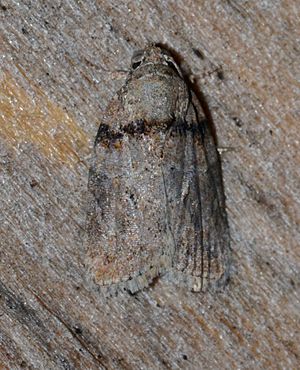Black-olive caterpillar facts for kids
Quick facts for kids Black-olive caterpillar |
|
|---|---|
 |
|
| Scientific classification | |
| Kingdom: | |
| Phylum: | |
| Class: | |
| Order: | |
| Family: |
Nolidae
|
| Genus: |
Garella
|
| Species: |
G. nilotica
|
| Binomial name | |
| Garella nilotica (Rogenhofer, 1881)
|
|
| Synonyms | |
|
|
The Garella nilotica is a small moth also known as the black-olive caterpillar or bungee caterpillar. It belongs to the Nolidae family of moths. This interesting insect was first described by a scientist named Alois Friedrich Rogenhofer in 1881.
About the Black-Olive Caterpillar
This moth is quite small. Its wingspan (the distance from one wingtip to the other) is about 15 millimeters. That's roughly the length of your fingernail!
Where Does This Moth Live?
The Garella nilotica moth lives in many warm parts of the world. Scientists call this a "pantropical distribution." You can find it in places like:
- Eastern North America, including Ontario, Quebec, Nova Scotia, New York, Florida, and Texas.
- The Caribbean islands.
- The Iberian Peninsula in Europe (which includes Spain and Portugal).
- Australia.
- Islands in the Pacific Ocean like Guam, Fiji, and Samoa.
- The Galápagos Islands.
- The Chagos Archipelago in the Indian Ocean.
What Do Black-Olive Caterpillars Eat?
The young moths, called larvae or caterpillars, are plant-eaters. They munch on leaves from many different kinds of trees and shrubs. These plants come from at least five different plant families! Some of their favorite foods include:
- Cynometra trees
- Heritiera trees
- Mangifera (mango) trees
- Terminalia trees
- Rhododendron bushes
- Bucida trees, like the Bucida buceras (black-olive tree)
- Canocarpus plants
- Olea (olive) trees
- Prunus (cherry, plum) trees
- Salix (willow) trees
- Tamarix shrubs

